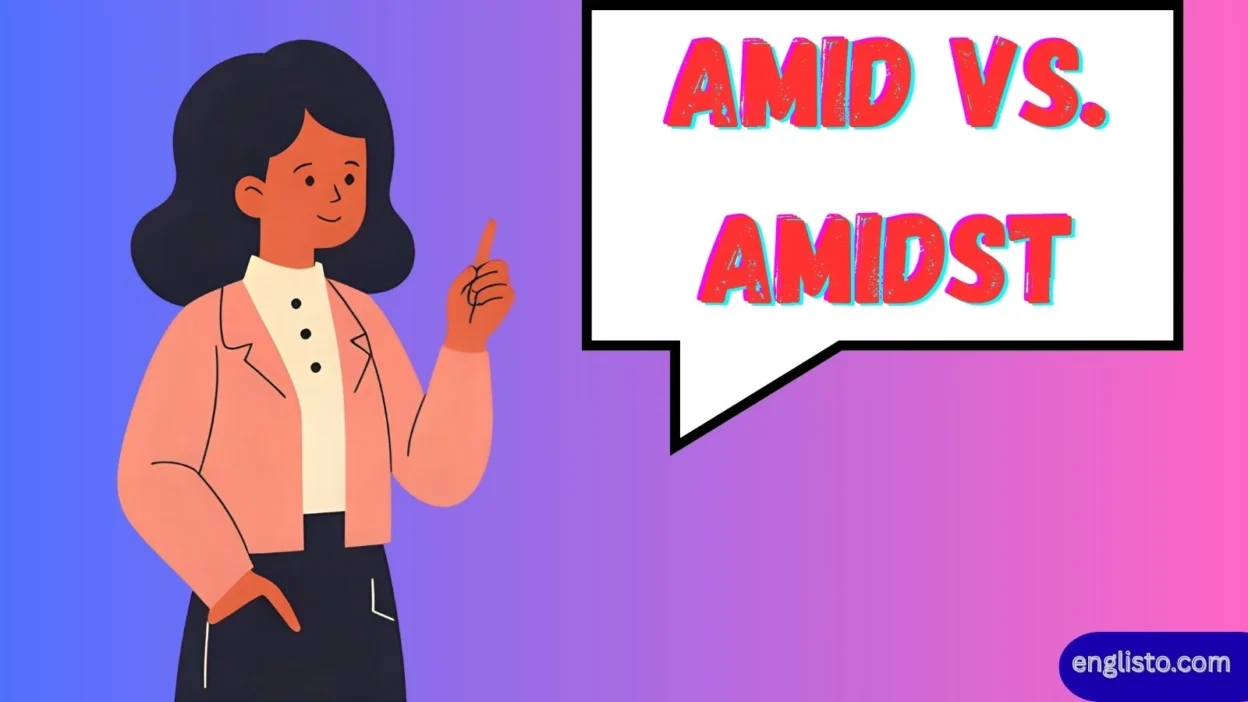Language is full of pairs that look alike, sound alike, and mean almost the same thing—but carry slight shades of difference. “Amid” vs. “Amidst” is one of those classic cases that often sparks curiosity among students, teachers, writers, and even seasoned professionals. If you’ve ever paused while writing a paper or crafting an essay wondering, “Should I use amid or amidst?”, you’re not alone. Amid vs. Amidst.
Both words are prepositions meaning “in the middle of” or “surrounded by.” Yet, they carry different stylistic tones, historical roots, and subtle connotations in American English and British English. In this guide, we’ll uncover their origin, frequency, cultural associations, and correct usage with examples, tables, and real-life contexts so you can confidently apply the right choice in your writing.
Origins of “Amid” and “Amidst”
The difference between these two words goes all the way back to Old English.
| Word | First Recorded | Root | Notes on Development |
| Amid | ~1000 AD | Old English ammidan / amidde | Derived from midde meaning “middle.” It has always meant “in the middle of.” |
| Amidst | ~1250–1300 AD | Variation of amid with the suffix -st | The -st ending was common in Middle English (also seen in amongst, whilst). It gave the word a slightly formal and poetic flavor. |
Amid is older and simpler.- Amidst came later as a stylistic variant, especially in British literature.
Interestingly, the -st suffix didn’t change the meaning. It was just a linguistic flourish that added rhythm and a sense of formality to speech and writing.
Read More: Has Run or Has Ran – Which Is Correct?
Pronunciation and Part of Speech
Both are prepositions and pronounced almost the same:
- Amid → /əˈmɪd/
- Amidst → /əˈmɪdst/
That tiny -st ending is what makes the difference in sound and stylistic register.
Meaning and Usage: Do They Differ?
At their core, both words mean:
- “In the middle of”
- “Surrounded by”
- “During” (when referring to time or events)
| Situation | Example with “Amid” | Example with “Amidst” | Notes |
| Physical place | “The cottage stood amid tall pine trees.” | “The cottage stood amidst tall pine trees.” | Both are correct. Amidst sounds more poetic. |
| Emotional / abstract | “She found peace amid chaos.” | “She found peace amidst chaos.” | Both work; amid feels modern, amidst feels lyrical. |
| Events / circumstances | “Amid growing controversy, the governor resigned.” | “Amidst growing controversy, the governor resigned.” | Both possible; newspapers usually prefer amid. |
The meaning doesn’t change. The choice is about tone, style, and tradition.
American vs. British English Preference
One of the most important distinctions lies in geography.
| Region | Favored Form | Notes |
| American English | Amid | Considered more natural, concise, and modern. Newspapers, schools, and professors prefer “amid.” |
| British English | Amidst (but both are common) | Seen more often in literary works, formal prose, and traditional texts. |
Examples:
- US headline: “Amid financial crisis, the company filed for bankruptcy.”
- UK headline: “Amidst allegations of corruption, the minister pleaded guilty.”
Style and Formality: When to Use Which
Think of “amid” and “amidst” like fashion choices. Both cover you, but one might suit the occasion better.
| Register | Better Choice | Why |
| Formal writing (essays, academic papers, reports) | Amid | Concise, clear, professional. Example: EasyBib recommends amid in school papers (Jan 17, 2023). |
| Literary writing (novels, poetry, historical prose) | Amidst | Carries a poetic, evocative, old-fashioned tone. Example: “Whispers arose amidst the oak grove.” |
| Journalism / News | Amid | Shorter and preferred for headlines. |
| Casual speech / everyday writing | Amid | Feels more natural and modern. |
Real-Life Examples
- Amid the noise of the city, she sat quietly reading a picture book.
- Amidst the ruins of the old town, a new policy arose to protect its heritage.
- The young student found optimism amid financial obstacles.
- A singer-songwriter stood on stage, basking in applause amidst confetti and cheers.
Subtle Distinction in Tone
Although interchangeable, the feeling they create differs slightly:
- Amid → direct, modern, neutral.
- Amidst → lyrical, formal, evocative, slightly old-fashioned.
Example:
- “She stood amid the crowd.” (Plain, straightforward)
- “She stood amidst the crowd.” (Adds a touch of drama or elegance)
Common Synonyms
Here are words you can use instead of amid or amidst:
| Synonym | Usage Example | Tone |
| Among | “Among the ruins, they found artifacts.” | Common, casual. |
| In the middle of | “In the middle of chaos, she remained calm.” | Clear, simple. |
| Surrounded by | “Surrounded by friends, he felt at ease.” | Visual, descriptive. |
| During | “During the celebrations, news of the victory erupted.” | Temporal, time-focused. |
| Within | “Within the forest, an eerie peace lingered.” | Formal, abstract. |
Common Mistakes and Tips
- Don’t use amidst if you’re aiming for conciseness in journalism or modern essays.
- Don’t confuse amid with among—though similar, among refers to being “included in a group,” while amid emphasizes being “surrounded by circumstances or things.”
- Use amidst if you want your sentence to feel poetic, literary, or historical.
Example:
- Correct: “Amid loud cheers, the performer took the stage.”
- Correct: “Amidst loud cheers, the performer took the stage.”
- Slight nuance: The first sounds like a report; the second reads like a novel.
Frequency and Popularity
Google Ngram Viewer shows that:
- Amid is far more common in contemporary English.
- Amidst peaked historically but is now used less frequently, surviving mainly in literature and British texts.
Usage in Modern Tools
- Grammarly → Suggests “amid” for clarity and conciseness.
- Dictionary.com, Cambridge, Merriam-Webster → List both as interchangeable, with notes on regional preference.
- Promova, Langeek, Grammarhow → Emphasize tone and stylistic choice.
Quick Reference Table
| Feature | Amid | Amidst |
| Origin | Older (1000 AD) | Later (1250–1300 AD) |
| Common in | US English | UK English |
| Tone | Concise, neutral, modern | Formal, poetic, lyrical |
| Contexts | News, essays, papers, professional writing | Literature, historical prose, artistic writing |
| Popularity today | Higher | Lower |
FAQs on “Amid” vs. “Amidst”
Q1. Are “amid” and “amidst” interchangeable?
Yes. They mean the same thing, but “amid” is more common and modern, while “amidst” adds a poetic or formal tone.
Q2. Which one should I use in academic writing?
Use amid—it’s shorter, clearer, and favored by teachers, professors, and style guides.
Q3. Why does “amidst” exist if it means the same as “amid”?
It’s a historical variant created in Middle English with the -st ending, similar to amongst and whilst.
Q4. Is “amidst” old-fashioned?
Not obsolete, but yes, it sounds more formal, literary, or old-fashioned compared to “amid.”
Q5. Which form do Americans and Brits prefer?
Americans usually choose amid, while Brits are comfortable with both, though “amidst” appears more in UK literature.
Conclusion
The debate between “amid” vs. “amidst” isn’t about correctness—it’s about style, tone, and context. Both words share the same meaning: “in the middle of” or “surrounded by.” Yet, amid is the modern, concise, American-friendly choice, while amidst carries a poetic, British, literary touch.
If you’re writing an essay, news article, or academic paper—stick with amid.
If you’re writing a poem, novel, or want to add elegance—choose amidst.
Language evolves, but knowing these subtle differences helps you write with precision, confidence, and rhetorical flair.



